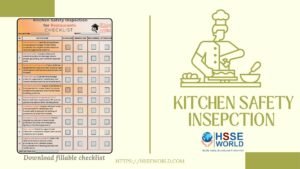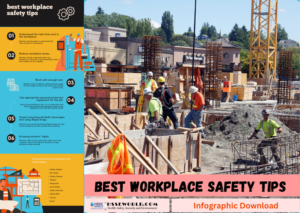Photo of the day: Why is PPE important?
Employers have duties concerning the provision and use of personal protective equipment (PPE) at work.
PPE is equipment that will protect the user against health or safety risks at work. It can include items such as safety helmets, gloves, eye protection, high-visibility clothing, safety footwear, and safety harnesses. It also includes respiratory protective equipment (RPE).
In the picture below try to find out Mandatory Personal Protective Equipment and answer why it’s very important

Why is PPE important?
Making the workplace safe includes providing instructions, procedures, training, and supervision to encourage people to work safely and responsibly.
Even where engineering controls and safe systems of work have been applied, some hazards might remain. These include injuries to:
- the lungs, eg from breathing in contaminated air
- the head and feet, eg from falling materials
- the eyes, eg from flying particles or splashes of corrosive liquids
- the skin, eg from contact with corrosive materials
- the body, eg from extremes of heat or cold
PPE is needed in these cases to reduce the risk.
What do I have to do?
- Only use PPE as a last resort
- If PPE is still needed after implementing other controls (and there will be circumstances when it is, eg head protection on most construction sites), you must provide this for your employees free of charge
- You must choose the equipment carefully (see selection details below) and ensure employees are trained to use it properly and know how to detect and report any faults
Selection and use
You should ask yourself the following questions:
- Who is exposed and to what?
- How long are they exposed?
- How much are they exposed to?
When selecting and using PPE:
- Choose products which are CE marked in accordance with the Personal Protective Equipment (Enforcement) Regulations 2018 – suppliers can advise you
- Choose equipment that suits the user – consider the size, fit, and weight of the PPE. If the users help choose it, they will be more likely to use it
- If more than one item of PPE is worn at the same time, make sure they can be used together, eg wearing safety glasses may disturb the seal of a respirator, causing air leaks
- Instruct and train people on how to use it, eg train people to remove gloves without contaminating their skin. Tell them why it is needed, when to use it and what its limitations are
Other advice on PPE
- Never allow exemptions from wearing PPE for those jobs that ‘only take a few minutes’
- Check with your supplier on what PPE is appropriate – explain the job to them
- If in doubt, seek further advice from a specialist adviser
Maintenance
PPE must be properly looked after and stored when not in use, eg in a dry, clean cupboard. If it is reusable it must be cleaned and kept in good condition.
Think about:
- using the right replacement parts which match the original, eg respirator filters
- keeping replacement PPE available
- who is responsible for maintenance and how it is to be done
- having a supply of appropriate disposable suits which are useful for dirty jobs where laundry costs are high, eg for visitors who need protective clothing
Employees must make proper use of PPE and report its loss or destruction or any fault in it.
Monitor and review
- Check regularly that PPE is used. If it isn’t, find out why not
- Safety signs can be a useful reminder that PPE should be worn
- Take note of any changes in equipment, materials and methods – you may need to update what you provide
Types of PPE you can use
Eyes
Hazards
Chemical or metal splash, dust, projectiles, gas and vapor, radiation
Options
Safety spectacles, goggles, face screens, face shields, visors
Note
Make sure the eye protection chosen has the right combination of impact/dust/splash/molten metal eye protection for the task and fits the user properly
Head and neck
Hazards
The impact from falling or flying objects, risk of head bumping, hair getting tangled in machinery, chemical drips or splash, climate or temperature
Options
Industrial safety helmets, bump caps, hairnets and firefighters’ helmets
Note
- Some safety helmets incorporate or can be fitted with specially-designed eye or hearing protection
- Don’t forget neck protection, eg scarves for use during welding
- Replace head protection if it is damaged
Ears
Hazards
Noise – a combination of sound level and duration of exposure, very high-level sounds are a hazard even with a short duration
Options
Earplugs, earmuffs, semi-insert/canal caps
Note
- Provide the right hearing protectors for the type of work, and make sure workers know how to fit them
- Choose protectors that reduce noise to an acceptable level, while allowing for safety and communication
Hands and arms
Hazards
Abrasion, temperature extremes, cuts and punctures, impact, chemicals, electric shock, radiation, biological agents, and prolonged immersion in water
Options
Gloves, gloves with a cuff, gauntlets, and sleeving that covers part or all of the arm
Note
- Avoid gloves when operating machines such as bench drills where the gloves might get caught
- Some materials are quickly penetrated by chemicals – take care in the selection, see HSE’s skin at work website
- Barrier creams are unreliable and are no substitute for proper PPE
- Wearing gloves for long periods can make the skin hot and sweaty, leading to skin problems. Using separate cotton inner gloves can help prevent this
Feet and legs
Hazards
Wet, hot and cold conditions, electrostatic build-up, slipping, cuts and punctures, falling objects, heavy loads, metal and chemical splash, vehicles
Options
Safety Boots and shoes with protective toecaps and penetration-resistant, mid-sole wellington boots and specific footwear, eg foundry boots, and chainsaw boots
Note
- Footwear can have a variety of sole patterns and materials to help prevent slips in different conditions, including oil – or chemical-resistant soles. It can also be anti-static, electrically conductive or thermally insulating
- Appropriate footwear should be selected for the risks identified
Lungs
Hazards
- Oxygen-deficient atmospheres, dust, gases, and vapors
Options – respiratory protective equipment (RPE)
- Some respirators rely on filtering contaminants from workplace air. These include simple filtering facepieces and respirators and power-assisted respirators
- Make sure it fits properly, eg for tight-fitting respirators (filtering facepieces, half and full masks)
- There are also types of breathing apparatus which give an independent supply of breathable air, eg fresh-air hose, compressed airline, and self-contained breathing apparatus
Note
- The right type of respirator filter must be used as each is effective for only a limited range of substances
- Filters have only a limited life. Where there is a shortage of oxygen or any danger of losing consciousness due to exposure to high levels of harmful fumes, only use breathing apparatus – never use a filtering cartridge
- You will need to use breathing apparatus in a confined space or if there is a chance of an oxygen deficiency in the work area
- If you are using respiratory protective equipment, look at the Respiratory protective equipment at work: A practical guide
Whole-body
Hazards
Heat, chemical or metal splash, spray from pressure leaks or spray guns, contaminated dust, impact or penetration, excessive wear or entanglement of own clothing
Options
Conventional or disposable overalls, boiler suits, aprons, chemical suits
Note
- The choice of materials includes flame-retardant, anti-static, chain mail, chemically impermeable, and high-visibility
- Don’t forget other protection, like safety harnesses or life jackets
Emergency equipment
Careful selection, maintenance, and regular and realistic operator training are needed for equipment for use in emergencies, like compressed-air escape breathing apparatus, respirators, and safety ropes or harnesses.
Download the photo
More photos:
- Photo of the day: Identify the Hazards
- Photo of the day: Hand safety Facts
- Photo of the day: What are the hazards
- Photo of the day: Outline Safety observations
- Photo of the day: Safety Leader
- Photo of the day: Unsafe Conditions
- Photo of the day: Why is PPE important?
- Photo of the day: DO’S and DON’TS of Working At Heights
- Photo of the day: 5 Tips to keep your Crew Healthy and safe at work
- Photo of the day: Tracking Near Miss Incidents
- Photo of the day: 10 Elements of Successful Behavior-Based Safety Program
- Photo of the day:5-Signs your Near-Miss Reporting is failing
- Photo of the day:7 Ineffective Safety Practices (And What To Do Instead)
- Photo of the day:5 keys for effective Self-Management in lone worker safety
- Photo of the day: FrontLine supervisors are the LINCHPINS of safety
- Photo of the day: Fostering Engagement at the front line
- Photo of the day: workplace Hazards
- Photo of the day: What is the line of fire
- Photo of the day: How to Avoid the Fatal Four
- Photo of the day: Fire Safety checklist for workplace
- Photo of the day: Most common safety incidents in the workplace
- Photo of the day: Fire Emergency
- Photo of the day: Ladder Safety Tips
- Photo of the day: 8 Basic steps to wear a safety harness
- Photo of the day: You can prevent workplace Falls
- Photo of the day: Top10 Injuries in office work
- Photo of the day: Overhead powerline safety
- Photo of the day: Eyes on the Road The challenges of safe driving
- Photo of the day: 5 Ways to Reinforce Commuting With Positive Reinforcement
- Photo of the day: Safe Lifting at work
- Photo of the day: 5 Essential outcomes of an effective leadership survey process
- Photo of the day: Conveyors Safety Tips
- Photo of the day: Confined Space rescue
- Photo of the day: Construction Site fire Safety
- Photo of the day: Chemical Spill Emergency Response
- Photo of the day: Electric shock survival
- Breath Safely: The Proper Use of Respiratory Protection
- Photo of the day: Confined space safety Precautions
- Photo of the day: Choosing the Right Face Mask and the difference between a respirator and face mask
- Photo of the day: Importance of Mock drill and Fire Action Emergency Procedure
- H2S Gas and how to handle its Emergency
- Your steps to chemical safety
- Photo of the day: hierarchy of controls
- Photo of the day: Tips to reduce Heat stress in the workplace
- Photo of the day: Safety Equipment for Confined Spaces
- Photo of the day: Dangerous Goods Classes
- Photo of the day: Trenching Safety Tips That Can Save a Life
- Photo of the day: Mental health in the workplace
- Photo of the day: Emergency preparedness in the workplace
- Photo of the day: musculoskeletal disorders
- Photo of the day: Workplace Inspection
- Photo of the day: New worker Orientation & Safety Orientation checklist
- Photo of the day: Effective Health and Safety Committees
- Photo of the day: 10 Scaffold Safety Essentials
- Photo of the day: Incident Investigations
- Photo of the day: Preventing the spread of contagious illness
- Photo of the day: 5 ways to reduce the risk of Slipping and Tripping
- Photo of the day: Sitting at work
- How to use Plate Clamps Safely: Safety Moment#34
- Photo of the day: working in heat and Humidex Rating
- Photo of the day: Don’t be Driven to Distraction
- Photo of the day: Fatigue at Work
- Photo of the day: Noise in the affected workplace
- Photo of the day: Indoor Air Quality
- Photo of the day: WHMIS 2015 – Pictograms
- Photo of the day: Personal Protective Equipment last resort
- Photo of the day: Manual Material handling
- Photo of the day: Controlling COVID-19 in the Workplace-Physical Barriers
- Photo of the day: Generator Safety
- Photo of the day: Position for safety and comfort-Safety Tips
- Photo of the day: Cannabis and Impairment in the Workplace
- Photo of the day: sun safety in the workplace
- Photo of the day: Top FIVE Heavy Equipment Construction Site Safety Tips
- Photo of the day: Work-Related Asthma
- Photo of the day: choosing the right Anchorage
- Photo of the day: Protect your Head
- Photo of the day: Extension Cord Safety Tips
- Photo of the day: Concrete Truck Driver Hand Signals
- Photo of the day: Safe use of ladders and step ladders
- Photo of the day: Arc-Fault Circuit Interrupters (AFCI)
- Photo of the day: HSE Bulletin Board
- Photo of the day: Scissor Lift Safety
- Photo of the day: Managing Risks of Exposure to Solvents in the workplace
- Photo of the day: Flagman and Traffic control
- Photo of the day: Run Project safely with Crane Hand Signals
- Photo of the day: Read All Labels Work safe
- Photo of the day: Flood Safety Tips
- Photo of the day: Fall Protection Plans
- Photo of the day: Lockout and Tagout Safety
- Photo of the day: Types of Hand Protection
- Photo of the day: Types of Foot Protection
- Photo of the day: Floor Marking
- Photo of the day: Overhead Power lines Clearance



